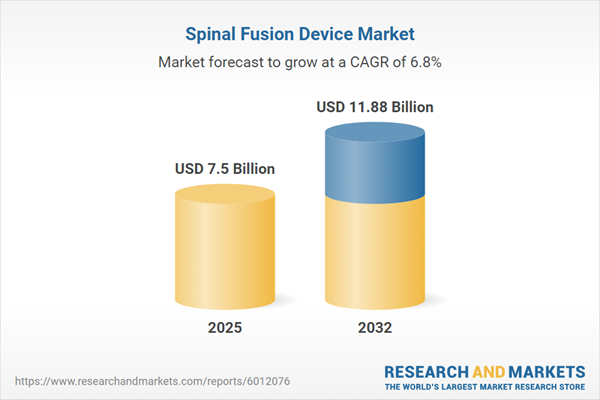Speak directly to the analyst to clarify any post sales queries you may have.
Senior decision-makers navigating the spinal fusion device market must respond to persistent shifts in clinical technologies, procurement practices, and regulatory environments. Strategic market intelligence remains essential to deliver competitive performance, operational agility, and resilient business models in this sector.
Market Snapshot: Spinal Fusion Device Market Trends and Growth Outlook
The spinal fusion device market is positioned for substantial growth, anchored by a rising global valuation and a steady compound annual growth rate.
Expansion is propelled by demographic changes associated with an aging global population and a growing prevalence of complex spinal disorders. The industry continues to prioritize innovations in advanced biomaterials and digital health technologies. Compliance with evolving international standards, as well as investments in research, development, and local manufacturing, are responses to diverse requirements across healthcare systems. These patterns underscore the importance of agile procurement and informed, data-driven investment decisions for senior leaders in the spinal fusion device market.Scope & Segmentation of the Spinal Fusion Device Market
- Product Types: Expandable and non-expandable interbody cages, rod and plate varieties, as well as cannulated, cortical, and pedicle screw formats allow providers to tailor surgical interventions and adapt to complex anatomical requirements.
- Surgical Approaches: Devices enable anterior, lateral, posterior, and posterolateral access, supporting customizable procedures that address diverse patient presentations and specific clinical priorities.
- Implant Materials: Titanium, PEEK, ceramic, and composite-based implants offer enhanced biocompatibility and device longevity, contributing to optimal patient outcomes in both acute and chronic care settings.
- Technique: Minimally invasive and traditional open techniques provide workflow flexibility, supporting hospital and outpatient workflow optimization as well as resource allocation.
- Applications: Devices address the cervical, lumbar, sacral, and thoracic spinal regions, promoting broad relevance for various clinical specialties and provider needs across orthopedic and neurosurgical fields.
- End Users: Hospitals and ambulatory surgical centers are primary adopters, seeking technology-driven improvements in patient care, procedural efficiency, and outcomes management.
- Geographic Regions: Strategic activities span the Americas, Europe, Asia-Pacific, Middle East, and Africa. Key markets such as the US, Canada, Brazil, China, India, Japan, and Australia reflect different regulatory priorities and reimbursement systems that shape the adoption landscape for spinal fusion devices.
- Company Coverage: Market leadership includes Medtronic plc, Johnson & Johnson, Stryker Corporation, NuVasive, Zimmer Biomet Holdings, Globus Medical, Orthofix Medical, B. Braun Melsungen AG, SeaSpine Holdings, and Alphatec Holdings. Each maintains a sustained focus on research-driven innovation and technology development.
Key Takeaways for Senior Decision-Makers
- Adopting intraoperative imaging and robotic-assisted systems ensures procedure consistency, driving improved clinical outcomes and supporting standardized protocols across institutions.
- Current regulatory and reimbursement developments favor the introduction of advanced biologics and innovative implants, encouraging providers to evolve care models toward greater value and patient focus.
- Localized production and investments in infrastructure, especially within Asia-Pacific and the Americas, are supporting faster technology adoption and improving supply chain resilience.
- Minimally invasive surgical techniques are being integrated more widely, facilitating shifts to ambulatory and outpatient settings while increasing access and adaptability for diverse patient populations.
- Industry collaborations are advancing digital workflow capability, enabling comprehensive care management from preoperative planning through postoperative monitoring and follow-up.
- Value-focused procurement strategies reinforce close supplier-provider relationships, promoting efficiency and clinical quality over time.
Tariff Impact on Supply Chain Strategies
Recent increases in U.S. tariffs on surgical devices and key raw materials, particularly titanium, necessitate strategic sourcing adjustments within the spinal fusion device market. Companies are mitigating exposure by diversifying suppliers, boosting local manufacturing, and opting for fixed price agreements where feasible. These measures help protect margins as well as promote ongoing research and rapid innovation cycles, supporting reliable market access and continuity of care.
Methodology & Data Sources
This research is built upon a diverse foundation, integrating clinical trials, regulatory data, and patent analytics. Input from orthopedic surgeons, procurement professionals, and health system executives delivers actionable intelligence with practical relevance. The methodological rigor ensures that findings offer credible support for decision-making in the spinal fusion device market.
Why This Report Matters for B2B Market Leaders
- Granular segmentation and a comprehensive technology landscape empower procurement and R&D teams to make more informed sourcing and development decisions regarding spinal fusion devices.
- Clarity on regulatory and reimbursement shifts enables more resilient business strategies and helps organizations anticipate challenges in global markets.
- Region-specific insights drive executive agility, supporting rapid adaptation and competitive positioning amid an evolving global marketplace.
Conclusion
The spinal fusion device market is evolving as industry participants prioritize technology adoption and operational excellence. Executive teams with access to precise market intelligence are positioned to identify growth avenues and support sustainable business progression in the sector.
Additional Product Information:
- Purchase of this report includes 1 year online access with quarterly updates.
- This report can be updated on request. Please contact our Customer Experience team using the Ask a Question widget on our website.
Table of Contents
3. Executive Summary
4. Market Overview
7. Cumulative Impact of Artificial Intelligence 2025
Companies Mentioned
The companies profiled in this Spinal Fusion Device market report include:- Medtronic plc
- Johnson & Johnson
- Stryker Corporation
- NuVasive, Inc.
- Zimmer Biomet Holdings, Inc.
- Globus Medical, Inc.
- Orthofix Medical Inc.
- B. Braun Melsungen AG
- SeaSpine Holdings Corporation
- Alphatec Holdings, Inc.
Table Information
| Report Attribute | Details |
|---|---|
| No. of Pages | 199 |
| Published | October 2025 |
| Forecast Period | 2025 - 2032 |
| Estimated Market Value ( USD | $ 7.5 Billion |
| Forecasted Market Value ( USD | $ 11.88 Billion |
| Compound Annual Growth Rate | 6.8% |
| Regions Covered | Global |
| No. of Companies Mentioned | 11 |









